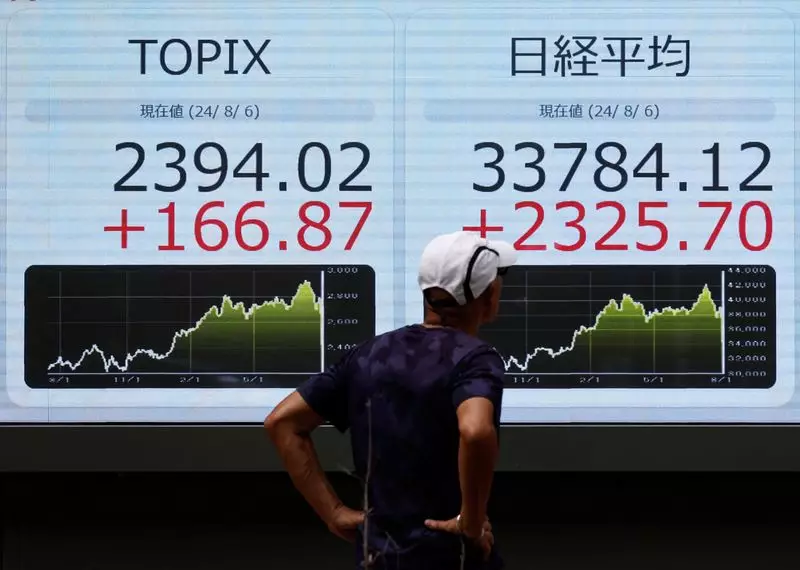In recent days, Asian stock markets have witnessed a surge, reaching the highest levels seen in over two months. This upward trend can be attributed, in large part, to shifts in U.S. monetary policy that have instilled a renewed sense of optimism among investors. The anticipation of potential rate cuts by the Federal Reserve has fostered a favorable risk environment, allowing Asian investors to reconsider their strategies. As market participants digest these developments, the focus now shifts to Australia, where the central bank’s impending policy decision has become a key area of interest.
China’s economic growth has faced significant headwinds, prompting the country’s financial regulators, including its central bank, to introduce a range of measures aimed at stimulating economic activity. Most notably, these measures include a reduction in mortgage rates for existing homeowners, an initiative designed to bolster consumer confidence and spending. The urgency of these reforms reflects a growing concern over the slowing economy, which could hinder China’s long-term growth prospects. Furthermore, as the People’s Bank of China takes proactive steps, market analysts remain vigilant, observing how these policies might influence investor sentiment both domestically and overseas.
As investors await the Reserve Bank of Australia (RBA) meeting, expectations have settled on a status quo approach when it comes to interest rates. Current sentiments among market analysts suggest that the RBA is likely to maintain its assertive posture vis-à-vis inflation, resisting calls for immediate cuts in rates. Charu Chanana from Saxo has indicated that a significant pivot may only arise during the RBA’s November meeting, potentially influenced by forthcoming labor market data and third-quarter Consumer Price Index (CPI) reports. This cautious stance illustrates the balancing act central banks face: fostering economic growth without igniting inflationary pressures.
The broader implications of these financial maneuverings extend beyond the Asian markets. The MSCI Asia-Pacific index, excluding Japan, has seen a nominal increase, reflecting the diversified reactions across the region. Notably, Japan’s Nikkei index surged significantly—by 1.69%—indicating strong domestic investor confidence ahead of an important speech from the Bank of Japan’s leadership. Meanwhile, as the Fed’s previous actions reverberate through global markets, U.S. stocks have also shown modest gains as traders attempt to unpack the ramifications of a 50 basis point cut in the federal funds rate.
Chicago Fed President Austan Goolsbee’s remarks resonate significantly within the current market climate, emphasizing the importance of maintaining equilibrium between the dual mandates of employment and price stability. The anticipation surrounding the Fed’s future rate decisions is palpable, with market analysts presenting mixed sentiments regarding potential further cuts. The CME FedWatch tool indicates a divide among traders, with a near-equal expectation of either a 50 basis point or a 25 basis point reduction in November, underscoring the uncertainty that typically characterizes Fed-related speculation.
In the currency markets, the U.S. dollar remains fragile as it hovers near a one-year low against a basket of major currencies. This weakness stems from the markets’ recalibrated expectations regarding the Fed’s trajectory, which in turn influences the strength of growth-sensitive currencies. Notably, the euro has stabilized despite recent disappointments in the euro zone economic indicators, while the Australian dollar, despite showing slight declines, remains close to its nine-month high. This volatility in currency values highlights the interconnectedness of global economic trends and their direct impacts on trade dynamics.
In the commodities sector, crude oil prices are showing slight increases as traders navigate ongoing concerns regarding demand and economic health. In light of fluctuating economic indicators from Europe and concerns over demand, the path forward for oil prices appears uncertain. As market observers continue to assess the ramifications of these interconnected global dynamics, the outlook remains cautiously optimistic. Investors are urged to consider both the macroeconomic signals and the subtle shifts in policy that could significantly alter market trajectories in the months to come.
As countries respond to evolving economic landscapes, vigilance and adaptability are crucial for market participants. Understanding these influences will be key to navigating the complexities of tomorrow’s financial environment.

